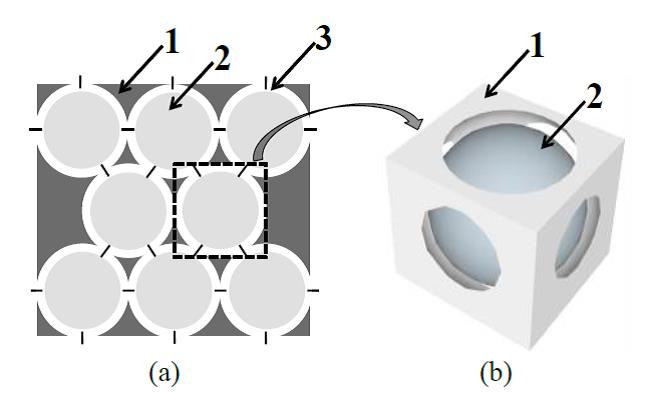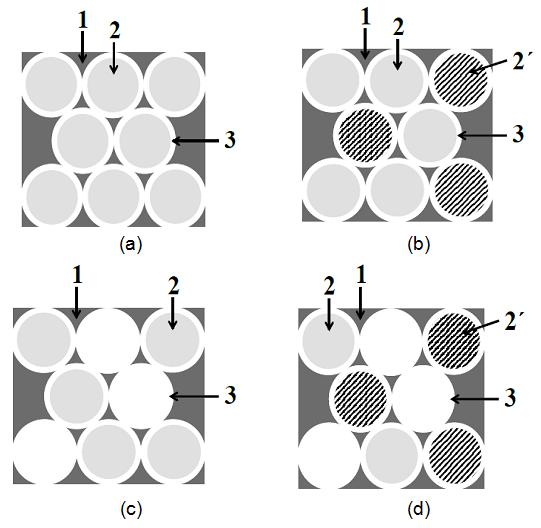Never miss an update from Javier Montiel Bonmatí
Create your free account to connect with Javier Montiel Bonmatí and thousands of other innovative organizations and professionals worldwide
The "Advanced Materials" research group at the University of Alicante has developed a foamed material comprising three phases: a structural matrix, at least one host phase, and a fluid. This material is characterized by the fact that the structural matrix comprises a plurality of interconnected porous cavities, the host phase(s) is/are housed within at least one porous cavity of the structural matrix and the fluid is housed within the porous cavities. The host phase(s) can be housed within the porous cavities of the structural matrix without maintaining any union or maintaining discrete unions with the latter.
The structural matrix may consist of a material of a metallic, polymeric, ceramic nature or mixtures thereof. Meanwhile, the host phase(s) is/are a functional material, the fluid being a liquid or a gas.
These materials have many potential uses, among which ones is as an implant material, with the additional possibility of exerting a controlled release of drugs.
Companies interested in commercial exploitation of this material through a patent license agreement are sought.
The research group "Advanced Materials" of the University of Alicante has developed a foamed material with application in implantology that comprises a structural matrix, at least one host phase and a fluid.
This foamed material is characterized because the structural matrix comprises a plurality of interconnected porous cavities, the host phase is housed inside at least one porous cavity of the structural matrix and the fluid is housed inside the porous cavity (Figure 1).

Figure 1. Schematic illustrating the interconnection of existing pores in a foamed material with structural matrix (1) and with host phase (2) and the way in which a host particle is housed in a porous cavity (3) of the foamed material. (a) two-dimensional drawing in which the lines represent interconnecting openings between pores; and (b) three-dimensional representation of a representative volume fraction containing a host particle housed in a porous cavity.
The host phase, in finely divided particle or fibre form, is housed within the porous cavity of the structural matrix, and can be:
• without maintaining any bond with it: between the walls of the porous cavity of the foamed material and the surface of the host phase there is a gauge of space that is occupied by the fluid.
• maintaining union with this structural matrix: between the walls of the porous cavity of the foamed material and most of the surface of the host phase there is a space gauge that is occupied by the fluid.
The structural matrix of the foamed material may consist of a material of a metallic, ceramic or polymer nature or mixtures thereof.
The host phase of the foamed material, preferably in a finely divided state (particles or fibres), is a functional material, i.e. any material that confers a certain function, such as, for example, an adsorbent function. These include: carbon, active carbon, organo-metallic skeleton materials (MOFs), etc. The foamed material can be made up of several host phases of a different nature, so that each of them provides a different functionality to the final foamed material.
The fluid inside the porous cavity of the foamed material can be a gas or a liquid. This fluid is found surrounding all or a large part of the host phase(s) in the porous cavity, in such a way that the fluid can circulate through the interior of the foamed material, as it has interconnected porosity, and renew itself if a pressure gradient is imposed at its ends.
The host phase(s) of the foamed material can be housed in all or part of the porous cavities, leaving the host phase free and the rest of the cavities completely occupied by the fluid (Figure 2).

Figure 2. Different types of foamed materials with host phases that can be obtained depending on the type of porous preform from which they are departing and with host phases that do not maintain union with the structural matrix. The legend corresponds to that in Figure 1: 1 is the structural matrix, 2 is the host phase and 3 is the porous space occupied by fluid or vacuum. 2' corresponds to a host phase other than 2. The porous cavities not occupied by the host phase are free to be fully occupied by the fluid or vacuum.
MAIN ADVANTAGES OF THE TECHNOLOGY
The foamed material described has the following advantages:
The competitive advantages of this material with respect to those used in traditional implantology are the following:
INNOVATIVE ASPECTS
In the field of implantology, there is no material with the characteristics of the described material.
CURRENT STATE OF DEVELOPMENT
The material has been developed on a laboratory scale, although the infiltration processes are easily scalable.
MARKET APPLICATION
The present invention falls within the field of foamed materials and in particular refers to an interconnected pore foamed material containing within its porous cavities at least one host phase, which gives specific functionalities to the foamed material.
This material is especially useful as an implant material. The material acts as an implant allowing the growth of living tissue in its interior with the adsorbent host(s), in such a way that it retains at least one substance with pharmacological activity in a living organism, so that this substance is released in a controlled way by desorption from the host phase in the living organism.
In addition to this use, foamed material may also be used:
COLLABORATION SOUGHT
The research group is looking for companies in the field of implantology interested in acquiring this technology for commercial exploitation through:
Ahead of the current Coronavirus outbreak, Innoget is fully committed to contributing to mobilizing scientific and expert communities to find a real solution to the Covid-19 pandemic. Therefore, we're supporting worldwide calls and programs that could help in any aspects of the coronavirus crisis.
Is your organization promoting or looking for innovation or research initiatives to mitigate the Covid-19 outbreak? Email us at covid19@innoget.com to list them.
Channeled through Innoget's online open innovation network, initiatives in the health, virology, medicine, or novel technologies applied to human health, among others, are listed and disseminated to Innoget members -ranging from hospitals, research institutes, scientists, businesses, and public administrations- and innovation partners worldwide.
Create your free account to connect with Javier Montiel Bonmatí and thousands of other innovative organizations and professionals worldwide
Send a request for information
to Javier
Technology Offers on Innoget are directly posted
and managed by its members as well as evaluation of requests for information. Innoget is the trusted open innovation and science network aimed at directly connect industry needs with professionals online.
Need help requesting additional information or have questions regarding this Technology Offer?
Contact Innoget support